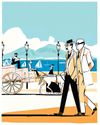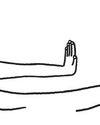
Some of my earliest memories are of summers with my grandparents, in New Delhi. I spent long, scorching months drinking lassi, playing cricket, and helping my grandparents find ripe mangoes at roadside markets. Then I’d return to the U.S., my English rusty from disuse, and go months or years without seeing them. At some point, my India trips started to feel like snapshots of loss. My grandfathers died suddenly, probably of heart attacks. My Biji, my father’s mother, fell and broke her hip in her seventies, and she spent her last years moving back and forth between her bed and her couch. My Nani, my mother’s mother, developed excruciating arthritis in both knees; in order for her to leave her fifth-floor walkup, my uncle practically had to carry her down the stairs. I have always wondered whether their fading vitality—the way their worlds contracted and their possibilities vanished—was an inevitability of aging or something that could have been averted.
This story is from the April 22 - 29, 2024 (Double Issue) edition of The New Yorker.
Start your 7-day Magzter GOLD free trial to access thousands of curated premium stories, and 9,000+ magazines and newspapers.
Already a subscriber ? Sign In
This story is from the April 22 - 29, 2024 (Double Issue) edition of The New Yorker.
Start your 7-day Magzter GOLD free trial to access thousands of curated premium stories, and 9,000+ magazines and newspapers.
Already a subscriber? Sign In

BADDIE ISSUES
\"Wicked\" and \"Gladiator II.\"

LET'S MAKE A DEAL
\"Death Becomes Her\" and \"Burnout Paradise.\"

ANTI HEROES
\"The Franchise,\" on HBO.

FELLOW-TRAVELLERS
The surprisingly sunny origins of the Frankfurt School.

NOW YOU SEE ME
John Singer Sargent's strange, slippery portraits of an art dealer's family.

PARIS FRIEND - SHUANG XUETAO
Xiaoguo had a terror of thirst, so he kept a glass of water on the table beside his hospital bed. As soon as it was empty, he asked me to refill it. I wanted to warn him that this was unhealthy - guzzling water all night long puts pressure on the kidneys, and pissing that much couldn't be good for his injury. He was tall, though, so I decided his insides could probably cope.

WILD SIDE
Is Lake Tahoe's bear boom getting out of hand?

GETTING A GRIP
Robots learn to use their hands.

WITHHOLDING SEX FROM MY WIFE
In the wake of [the] election, progressive women, who are outraged over Donald Trump's victory at the ballot box, have taken to social media with public, vengeful vows of chastity. - The Free Press.

DEADLINE EXTENSION
Old age, reborn.